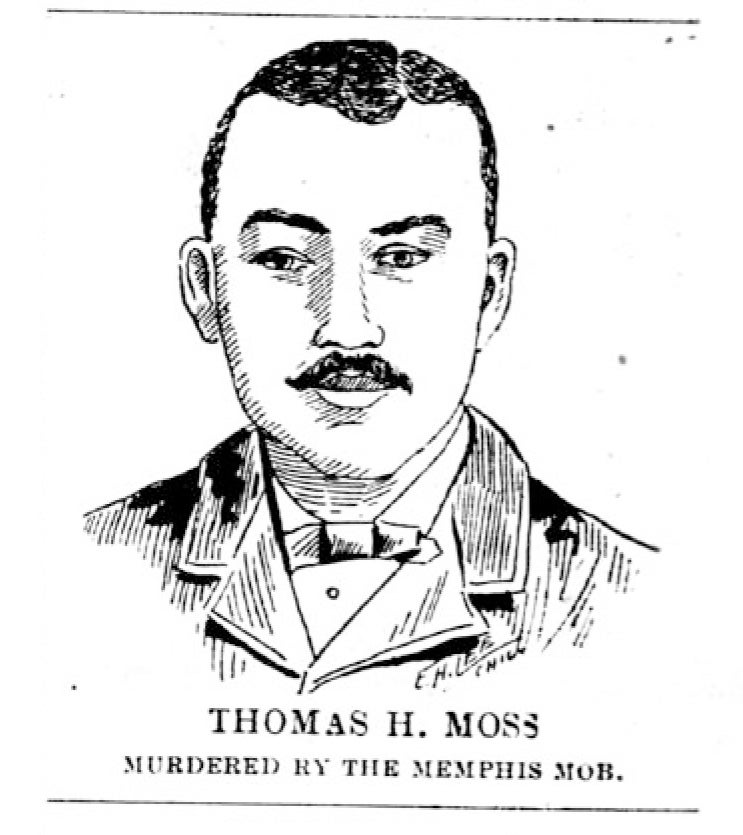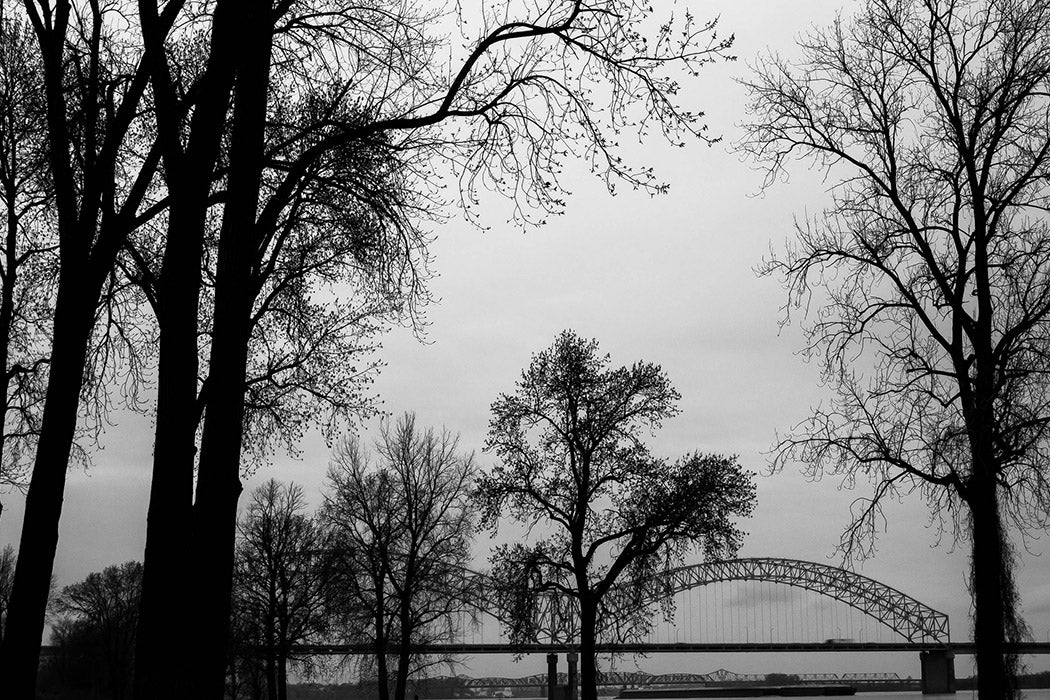“To Punish the Lynchers: Memphis Negroes Thirsting for Vengeance,” read the March 11, 1892 headline in The New York Times. Two days earlier, People’s Grocery owner Thomas Moss had been lynched alongside two of his workers, Calvin McDowell and Will Stewart, by a white mob that accused Moss of plotting a war against whites. The local paper, the Memphis Appeal Avalanche, described the lynchings as a skillful execution, with the corpses of Moss, McDowell, and Stewart left to rot in the Chesapeake & Ohio railroad yard a mile outside of Memphis, Tennessee.
Moss, a dark-skinned, chin-bearded, 150-pound man, lay shoeless with his face to the earth. Stewart, the grocery clerk, lay with a shotgun hole in the right side of his neck. To the south of them lay McDowell, a light-skinned, curly-haired, 200-pound man, butchered to the point of dismemberment. “There were four holes in his face and neck, any one of them large enough to allow the insertion of a person’s fist,” the Appeal Avalanche reported.
The lynchings came 27 years after the defeat of the Confederacy. They marked the breaking point that led to investigations by journalist Ida B. Wells, whose stories in the Memphis Free Speech exposed the real reasons behind the lynchings.
They were the first lynchings since the Civil War, explains Wells—who was a dear friend to Moss—in her book Crusade for Justice: The Autobiography of Ida B. Wells. At the time, Moss was enjoying the fruits of a successful business. The cooperative economics enterprise he founded in 1889, People’s Grocery, was a booming business in the “Curve,” a mixed race neighborhood, which at the time was the Shelby County, Tennessee fourteenth civil district, just outside Memphis.
In Ida: A Sword Among Lions, the historian Paula J. Giddings explains that when Moss’ grocery opened, “Memphis had emerged as the fifth-largest wholesale grocery market in the country.” As a result, his business was an instant success. The grocery not only brought capital to the black Memphians in the community, but also a sense of pride. However, not all Memphians saw People’s Grocery this way: William Barrett, a white grocer whose store had served the community before the black grocery arrived, felt threatened by the store.
After the Civil War, racial tensions in the South remained high. As blacks began to rid themselves of debt, white Southerners turned to racial violence, targeting blacks who they perceived as having too much ambition, property, talent, or wealth. According to the historian Joel Williamson, the majority of victims were lynched for the social crime of being economic competitors to whites. Often, the lynchings were justified under claims that the victims had either sexually assaulted white women or committed an unspecified barbaric act against whites.

Moss was known as a family man in the community. He delivered mail by day and ran People’s Grocery by night. But neither his social nor economic status saved him from the racial hostility of the South. According to Giddings, by 1890, the Curve was experiencing the worst social problems in Memphis as it “was outside of Memphis proper and had only token police enforcement,” making it a destination for crime.
Memphis was dominated by Democrats. Blacks were marginalized into pockets of poverty, as well as pushed into the Curve, which whites began to abandon. Eventually, in 1891, Memphis became a prime location for gambling houses, the liquor business, gangs, and other illegal activity. By that time, racial animosity had greatly increased.
Barrett’s jealousy over the success of People’s Grocery made race relations even worse. As the black grocery grew, the white grocery declined, and it wasn’t long before Barrett, whose grocery became known by both blacks and whites as a place of illicit activity, began making trouble with his competition. Before that, Barrett had been ticketed ten times for violating the local liquor law, Giddens explains.
In the beginning, Moss shrugged off Barrett’s animosity and didn’t worry, as the majority of the residents in the Curve were either black or belonged to his church. But in 1892, Barrett’s jealousy became impossible to ignore.
On March 2, a racially charged mob grew out of a fight between a black and a white youth who were playing marbles in a yard near Moss’ grocery. When the black youth won the fight, the white youth’s father jumped in to avenge his defeat. Before long, Calvin McDowell and Will Stewart came to the black youth’s defense, beating up the father who assaulted him. As the fight went on, a crowd of blacks and whites gathered at the scene, many picking sides based on race. “During the melee, William Barrett, the white proprietor and competitor who had been giving Moss trouble, got clubbed near the black man’s store. He identified Will Stewart, the clerk of the People’s Grocery, as his assailant,” Giddings writes. The incident gave Barrett the fuel he needed to make a case to the authorities against Moss and his business—that is to say, that the long-standing claim of blacks belonging to a violent race was true.
On March 3, Barrett entered People’s Grocery with a police officer in hopes of arresting Stewart, but he was not there. Stewart’s absence angered Barrett. Frustrated, Barrett knocked McDowell to the floor after striking him with a revolver. The gun dropped, and McDowell picked it up from the floor and shot toward Barrett, who retreated along with the officer. Later, McDowell was arrested for the dispute, then released on bond. All the while, a judge had issued arrest warrants for both Stewart and the black child who participated in the initial fight.
As word of the fight spread through the neighborhood, Barrett alleged to Shelby County criminal court Judge Julius DuBose that the Curve’s black residents held a secret meeting in which they plotted a conspiracy against whites. After hearing the allegations, Judge DuBose vowed to put together a posse to “get rid” of the “rowdy” black residents in the Curve. The local media fueled the flames by publishing the judge’s promise in Saturday’s paper.
That same day, racial tensions in the neighborhood heightened after a black painter was shot by a white grocery clerk who ran a separate store in the area. By this time, the People’s Grocery men grew concerned that they’d be attacked by a white mob, and sought the advice of an attorney on how to defend themselves. Outside of the Memphis jurisdiction, they were ineligible for police protection. “Accordingly the grocery company armed several men and stationed them in the rear of the store on that fatal Saturday night, not to attack but to repel a threatened attack,” Wells writes.
At 10 p.m., DuBose’s posse of white men—a county sheriff and five deputized civilians— approached the rear of People’s Grocery after convening at Barrett’s establishment, Wells recounts. The men who were stationed at the rear fired at the posse without hesitation. Immediately, a shootout between the groups ensued. After the gun battle, several of the posse members were hit. The injured whites were evacuated for medical treatment, and another group of deputized white civilians were dispatched to the grocery.
Wells asserts that more than one hundred blacks were taken from their homes and jailed the morning after the incident. Among them were Moss, McDowell, Stewart, and the black boy who was involved in the fight that sparked the incident. The newspapers fanned the flames throughout the week, labeling the incident as proof of the conspiracy that Barrett warned DuBose about. “Reports in both the Commercial and Appeal Avalanche characterized the shooting incident as a calculated, cold-blooded ambush meant to kill the whites who had come to the store,” Giddings writes.
The reports influenced crowds of armed white men to stand outside the Shelby County Jail, where the People’s Grocery men were held until the judge could confirm whether the “deputies” injured in the shootout would survive. The men were not to be punished until this was revealed. For protection, the Tennessee Rifles, a black militia to whom McDowell belonged, stood guard outside the walls of the jail in an effort to guard against a brutal lynching. By Monday, March 8, news broke that the “deputies” would survive, and the black militiamen perceived this as a sign that there wouldn’t be any violence against the black grocery men—for this reason, they chose to leave.
On Tuesday, March 9, in the wee hours of the night, 75 men stormed the walls of the Shelby County Jail, and a small group entered in search of Moss, McDowell, and Stewart. The three men were dragged from their cells, loaded onto a switch engine that ran at the back of the jail house, transported to a railroad yard north of the city’s limits, and shot to death in retaliation.
The lynchings of Moss, McDowell, and Stewart were done in secret, but for a public audience. The periodicals of the time framed the lynchings as the natural consequence of carrying out an ambush-style conspiracy against the town’s whites. The Austin Weekly Statesman reported that the People’s Grocery men had led the Shelby County “deputies” into an ambush. But Moss’ lynching, like many others in the South, was an organized act of extralegal violence, a punishment for becoming an economic competitor to whites.
Get Our Newsletter
At daybreak, when word of the lynchings spread, DuBose ordered the confiscation of the weapons belonging to the Tennessee Rifles. He then directed the sheriff to take a hundred men to the Curve and “shoot down on sight any Negro who appears to be making trouble.” With the blessings of the court, the fate of Moss’ grocery was left in the hands of gangs of armed white men who were itching for trouble. To prevent further violence, the black men in the neighborhood decided not to confront the mob, Wells explains. “They realized their helplessness and submitted to outrages and insults for the sake of those depending on them,” she writes. Thus, the mob was free to loot Moss’ establishment, eating and stealing what they could, and destroying what they could not.
“The creditors had the place closed a few days later and what remained of the stock was sold at auction.” Thus, Barrett, having ironically been the buyer of what was left of People’s Grocery, had successfully gotten rid of the black competitor he grew to resent.







